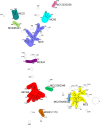Microfluidic-chip-based multiple-locus variable-number tandem-repeat fingerprinting with new primer sets for methicillin-resistant Staphylococcus aureus
- PMID: 22573591
- PMCID: PMC3405612
- DOI: 10.1128/JCM.00056-12
Microfluidic-chip-based multiple-locus variable-number tandem-repeat fingerprinting with new primer sets for methicillin-resistant Staphylococcus aureus
Abstract
The detection of outbreaks of methicillin-resistant Staphylococcus aureus (MRSA) infections and a rapid and accurate identification of sources and routes of transmission should be conducted in hospital settings as early and swiftly as possible. In this study, we investigated the application potential of a new approach based on multiple-locus variable-number tandem-repeat fingerprinting (MLVF) and microfluidics technology for a rapid discrimination of MRSA lineages in outbreak settings. A total of 206 nonrepetitive MRSA isolates recovered from infected patients at the University Medical Center Groningen between 2000 and 2010 were tested. The results obtained by MLVF using microcapillary electrophoresis with newly designed primers were compared to those obtained by spa typing and multiple-locus variable-number tandem-repeat analysis (MLVA). The discriminatory power was 0.980 (107 patterns), 0.969 (85 allelic profiles), and 0.959 (66 types) for MLVF, MLVA, and spa typing, respectively. All methods tested showed a good concordance of results calculated by the adjusted Rand's coefficient method. Comparisons of data obtained by the three approaches allowed us to propose an 88% cutoff value for the similarity between any two MLVF patterns, which can be used in S. aureus epidemiological studies, including analyses of outbreaks and strain transmission events. Of the three tested methods, MLVF is the cheapest, fastest, and easiest to perform. MLVF applied to microfluidic polymer chips is a rapid, cheap, reproducible, and highly discriminating tool to determine the clonality of MRSA isolates and to trace the spread of MRSA strains over periods of many years. Although spa typing should be used due to its portability of data, MLVF has a high added value because it is more discriminatory.
Figures



References
Publication types
MeSH terms
Substances
LinkOut - more resources
Full Text Sources
Medical

